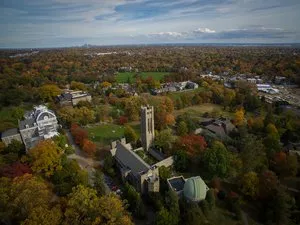These Walls Can Talk


Lee Smithey is an assistant professor of sociology, whose research interests focus on nonviolent social movements, ethnopolitical conflict, and conflict transformation, especially in Northern Ireland. Smithey, who coordinates the Peace and Conflict Studies Program, has been closely involved with the creation of Swarthmore's Semester in Northern Ireland, providing students with both academic and community-based experiential learning in a setting where they can participate in local peace building efforts. Write to him at lsmithe1@swarthmore.edu.
Many people probably think the long struggle over civil rights, equality and the political status of Northern Ireland has been resolved. In some important respects, they are correct. The political peace process that led to the 1998 Belfast / Good Friday Agreement has resulted in substantial demilitarization, the decommissioning of many paramilitary weapons and several organizations, the establishment of a powersharing government, and policing and other reforms. Yet, Northern Ireland remains highly segregated along political, educational, religious, and geographic lines (to name a few). Thankfully, though some political violence remains, much contention has moved into the arena of party politics, and it continues to play out in symbolic and cultural realms.
Several years ago, I became interested in studying a range of expressions of Protestant/unionist/loyalist collective identity in Northern Ireland. While conducting field work, I took hundreds of photos of murals in loyalist neighborhoods, documented the changing complexion of the symbolic landscape, and confirmed that violent and paramilitary images are being replaced by a range of historical, local, and other themes. This is good news, as one might expect a less-violent symbolic environment to help improve community relations by lowering levels of intimidation, especially at interfaces between urban Protestant and Catholic neighborhoods.
My research experiences lined up with conversations I had been having with Gregory Maney, associate professor of sociology at Hofstra University, who also studies Northern Ireland. We decided to initiate a Mural Mapping Project that uses geographic information systems (GIS) technology and qualitative methods to track over time the location, production, and content of murals and other semi-permanent ethnic and political displays—such as memorial gardens, monuments, or sculptures. Our systematic cross-community approach catalogs these murals in every street in West Belfast and the Shankill Road, areas that incorporate Protestant/unionist/loyalist and Catholic/nationalist/republican neighborhoods.
While following the removal, replacement, and redesign of murals over time, we can track their development alongside changing political, cultural, and social contexts. We hypothesize that although armed conflict remains part of the West Belfast landscape, republicans and loyalists are increasingly emphasizing other themes, such as athletics, in their murals and memorials, both reflecting and shaping their collective identities as part of the peace process.
One of the exciting aspects of this work has been the opportunity (with support from the Hungerford Fund) to partner with Swarthmore students who study abroad in Northern Ireland. The Northern Ireland Semester is a community-based learning program offered in conjunction with the peace and conflict studies curriculum at the Irish School for Ecumenics, a satellite campus of Trinity College (Dublin) in Belfast.
During the 2009-2010 academic year, Samia Abbass '11 and Devon Novotnak '11 travelled the streets of West Belfast with a guide, Jayne McConkey, photographing and documenting the locations of murals, memorial gardens, plaques and other public displays of ethnopolitical identity. Their data has been compiled into a growing electronic database that will expand with further longitudinal research.
As the project develops, we plan to involve local community organizations and civil service agencies in the research to help ensure that the results can be of benefit to community development and community relations initiatives.



